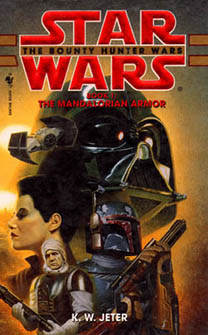No doubt the “Bounty Hunter Wars” trilogy drew a lot of readers simply because of its subject matter: Finally, a chance to learn more about Boba Fett and the other bounty hunters! However, the response to the first book, “The Mandalorian Armor” (1998) — to judge by Amazon reviews — is decidedly mixed, largely because K.W. Jeter has a love-it-or-hate-it writing style.
Michael Stackpole (one of my favorite “Star Wars” authors) has said short paragraphs are the key to good writing. Jeter eschews that advice, penning massive chapters that stick with a single set piece. Chapter 16, which entirely chronicles Fett’s conversation and subsequent showdown with the Shell Hutt Gheeta, covers 43 pages. This trilogy is by no means efficiently written; the plot could’ve fit into one book. Every little thing is analyzed and talked about between characters; sometimes a second character is in a scene purely to serve as a sounding board. While those sound like criticisms, I actually enjoyed “The Mandalorian Armor” when it came out, and again on this re-read.
Jeter’s style is akin to Troy Denning’s and Karen Miller’s; it delves heavily into characters’ schemes and plot machinations. But I think Jeter’s a better writer than those two; although “The Mandalorian Armor” is dense, like a GFFA “Godfather,” I didn’t have any trouble keeping up with who was stabbing whom in the back.
Although there’s definitely a noir tint to Jeter’s style — even scenes that should be emotionally charged are presented matter-of-factly — his characterization is spot on, and he adhered to the lore at the time, which primarily sprung from “Tales of the Bounty Hunters” and “Shadows of the Empire.”
Dengar, now with a spark of compassion after being married to Manaroo (chronicled in “Dengar’s Tale”), nurses Boba Fett — having escaped from the Sarlacc Pit in “Tales from Jabba’a Palace” — back to health in a cave on the Dune Sea of Tatooine. Joining them is the amnesiac former Jabba’s Palace-dancer Neelah, who believes Fett holds the key to her past. Meanwhile, Bossk is pleased that Fett is finally dead (although, in true Trandoshan form, he wishes he could’ve killed Fett himself), but then he’s angry and scared when he learns Fett isn’t dead. Plus, in a Denning-esque twist, both Fett and Bossk know Xizor was on hand when stormtroopers killed Luke’s aunt and uncle (!).
Those events take place during “Return of the Jedi.” But many chapters bounce back to the time between “A New Hope” and “Empire,” when Fett aims to destroy the Bounty Hunters Guild from within. Three other galactic movers-and-shakers — Prince Xizor, Kuat of Kuat and Kud’ar Mub’at — also have a stake in this, but as far as Fett’s concerned, he wants to dismantle the guild to end its strength in numbers and therefore get higher bounty payouts. Our favorite bounty hunters are nicely in character: Bossk is entertainingly angry and vengeful; Zuckuss is not quite cut out for the trade; Fett is his calm, collected and oh-so-cool self. Jeter doesn’t seem interested in doing much with IG-88, although he is present and accounted for; 4-LOM is the only one of the “big six” from “Empire” not on board here.

One continuity oddity is that Jeter notes that Bossk is younger than the veteran Fett; in “The Clone Wars,” we see that Bossk is actually among young Boba’s mentors. Fortunately, that incorrect detail doesn’t affect the plot or characterization of “The Mandalorian Armor” any. (He may technically be younger, but at this point, Fett is indeed better at his job than Bossk.) Another minor glitch relates to the Goodwin/Williamson newspaper strip “Showdown” — set after the flashback portions of this trilogy — where Fett works with Bossk and Dengar to nab Han and Luke, contradicting the assumption that Fett prefers to work alone.
In addition to having a nourish quality, Jeter is also a talented sci-fi imaginer in the vein of Philip K. Dick. In fact, Jeter wrote two very good sequels to Dick’s “Do Androids Dream of Electric Sheep?,” which was adapted into the movie “Blade Runner.” That wonderfully weird PKD-ian touch comes through in Kud’ar Mub’at, who I picture as a giant space spider; D’harhan, who is part-organic, part-weapon, like General Grievous on steroids; and a pair of chatty medical droids who marvel at how they have to keep patching up Fett.
A reader could nitpick Jeter’s writing, and many have. In some cases, he goes too far out of his way to avoid Earth terms, such as using “standard time parts” instead of “seconds.” He also really likes the word “barve” (essentially “Star Wars” for “bastard” or “sonofabitch”). At other times, he whiffs on proper “Star Wars” language, saying “paper” instead of “flimsi,” and noting that Bossk is “pissed off” (a modern American term that can distract a reader). That’s all small potatoes if you’re into the flow of the book, though.
Fair warning, even for Fett fans: You have to be in the right mindset to enjoy “The Mandalorian Armor.” You have to be willing to dig into the dark, dank trenches of “Star Wars” and spend a lot of time there. But bounty hunters and their world are a good fit for Jeter’s style; it’s not mainstream, adventurous “Star Wars,” but then bounty hunters aren’t in the mainstream of the GFFA.
What are your thoughts on “The Mandalorian Armor” and Jeter’s storytelling style? Are you in the “love it” or “hate it” camp, or somewhere in between?
Comments
![]() I always liked Boba Fett but very few stories uses him as a good protagonist, this one, fortunately, is one of them! I am with the people that love this trilogy, I know that this isn’t a masterpiece and can be tiring sometimes, but there are a lot of fun going on. At the end it is in the same category of the Truce at Bakura, of good and fun but not great Star Wars stories .# Posted By Eric | 10/2/13 10:45 PM
I always liked Boba Fett but very few stories uses him as a good protagonist, this one, fortunately, is one of them! I am with the people that love this trilogy, I know that this isn’t a masterpiece and can be tiring sometimes, but there are a lot of fun going on. At the end it is in the same category of the Truce at Bakura, of good and fun but not great Star Wars stories .# Posted By Eric | 10/2/13 10:45 PM
![]() Indeed, this trilogy may be overwritten, but this is Boba Fett at the top of his game. And I also enjoy the characterization of Bossk. I’ve heard this trilogy being criticized for continuity, but at least the gaffes are mostly minor. Even with the new Fett backstory from the prequels, I haven’t encountered anything that’s way off base other than the mention that Bossk is younger than Fett.# Posted By John Hansen | 10/3/13 1:17 AM
Indeed, this trilogy may be overwritten, but this is Boba Fett at the top of his game. And I also enjoy the characterization of Bossk. I’ve heard this trilogy being criticized for continuity, but at least the gaffes are mostly minor. Even with the new Fett backstory from the prequels, I haven’t encountered anything that’s way off base other than the mention that Bossk is younger than Fett.# Posted By John Hansen | 10/3/13 1:17 AM

